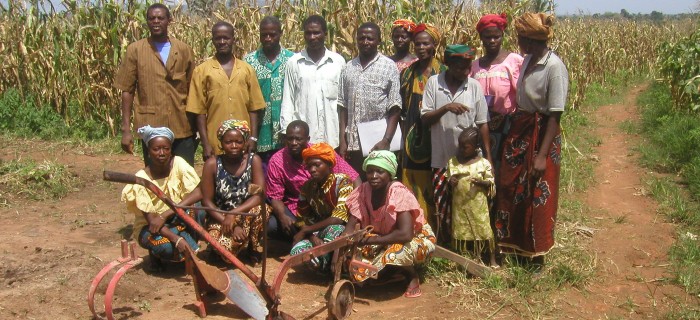Burkina Faso’s Farmer-to-Farmer Movement Helps Smallholders Cope with Climate Change
The half-moon ridges sculpted in the red dirt didn’t look like much. Eight feet across and barely five inches high, they bent around the stubble of half a dozen millet plants. There were scores of these ridges carefully arranged in the dusty two-hectare field where a young peasant couple farming near the town of Gayeri raised crops to feed their growing family. “It’s our experiment,” they explained, “We use the half-moon to conserve water. We also put a handful of compost in the hole where we plant the millet. It conserves moisture. These two techniques increased the yield of our millet by almost double compared to that grown traditionally in the rest of the field.”
Next to the plot of half-moons was another experiment called “zai” with ridges forming interlocking rectangles. There was also a series of Cordons pierreux, low rock walls with the remnants of grasses along one side that also captured water. Other farmers were experimenting with legume cover crops in rotation with millet. Each experiment was carefully monitored and measured and compared against the control plot (which was the rest of the field). This way, farmers could test three, four and even five innovations at once without jeopardizing their seasonal crop.
I was the guest of Fatou Batta, director of the Association Nourrir Sans Detruire (ANSD) who had invited us to see their farmer-to-farmer agricultural development work in eastern Burkina Faso near the city of Fada. I travel with other visitors from Ghana, Senegal and Mali who are all part of the We Are the Solution campaign, a regional grassroots effort funded by the International Fund to Amplify Agro-Ecological Solutions (IFAAES). Villagers are working Farmer-to-Farmer to find local, practical alternatives to the much-touted—but dangerously flawed—New Green Revolution.
The farmers in the We Are the Solution campaign are developing a wide repertoire of sustainable agriculture skills specific to the extreme conditions of Burkina Faso’s dry savannah.
Most of Burkina Faso is flat, dry, Sub-Saharan savanna, and the area around Fada is no exception. Rural populations live grouped loosely around natural and constructed shallow pans of water harvested during 3-4 months of torrential rains. This moisture must last them through the 8-month dry season. Farmers complain that the rains are failing and that the dry season is longer and hotter due to climate change. The zai and the half-moon replicate natural water harvesting on a micro scale. The technologies—while labor intensive to establish—are simple, cheap and effective in the face of deteriorating weather patterns.
We visited a village where teams of women farmers were teaching others how to make compost. They used dry fodder, animal manure and precious water from their communal well. A dry-climate technique that was new to me was to tamp down the compost pile as it was being built, squeezing out all of the air. “This is so it the pile does not dry out,” explained the farmer-technician, “There is plenty of air in the dried stalks we are using to insure the composting process.”
Another strategy that is steadily rolling back the advancing Sahara Desert is FMNR—Farmer Managed Natural Regeneration. Infinitely more successful than reforestation, this approach manages naturally-occurring tree species within cultivated fields to provide fodder, firewood and nutrients to farmers and pastoralists.
Around the pans and reservoirs, people take advantage of residual moisture and high groundwater to grow vegetables. Nourirre sans Destruir helped a women’s group near Gayeri negotiate for land, fencing and a well to start a subsistence and market garden that serves over 30 families.
Stay in the loop with Food First!
Get our independent analysis, research, and other publications you care about to your inbox for free!
Sign up today!The farmers in the We Are the Solution Campaign are developing a wide repertoire of sustainable agriculture skills specific to the extreme conditions of Burkina Faso’s dry savannah. They are shared farmer to farmer, village to village to build regional food security.
These village-level strategies stand in stark contrast to the Alliance for a Green Revolution in Africa (AGRA) financed by the Bill and Melinda Gates Foundation and to pretty much everything in the G-8’s New Alliance for Food Security and Nutrition. Dependent on micro-credit, fertilizers and hybrid seed, these initiatives gravitate to those areas with more favorable agronomic conditions. In the harsh agroecosystems of Burkina Faso, the Green Revolution techniques fail, driving farmers into debt and worsening rather than alleviating food insecurity. The farmer-led agroecology practiced by Nourrir sans Destruir, however, is adopting, adapting and spreading the proven, highly productive, low-cost, sustainable methods that increase food production and improve family livelihoods and the environment.
Food First is partnering with Groundswell International and ILEIA-Netherlands to support We Are the Solution and other effective, farmer-led alternatives to the Green Revolution in Africa. We are working together to produce agroecological learning materials and Policy Briefs to support women’s farmer organizations on the ground and national/regional campaigns for food sovereignty and agroecology.


 Help Food First to continue growing an informed, transformative, and flourishing food movement.
Help Food First to continue growing an informed, transformative, and flourishing food movement.




